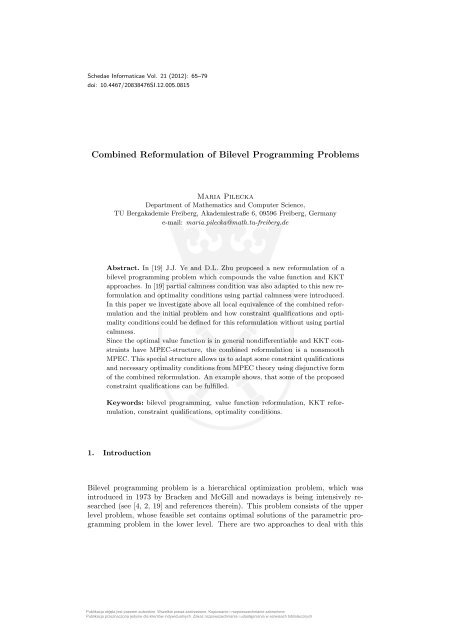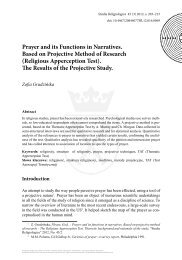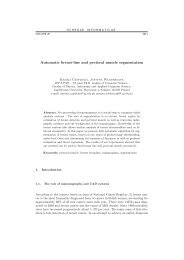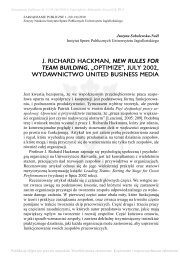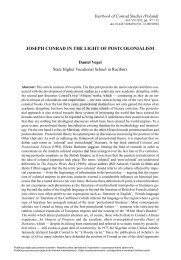Combined Reformulation of Bilevel Programming Problems
Combined Reformulation of Bilevel Programming Problems
Combined Reformulation of Bilevel Programming Problems
You also want an ePaper? Increase the reach of your titles
YUMPU automatically turns print PDFs into web optimized ePapers that Google loves.
66problem, which is in general a set valued optimization problem: pessimistic andoptimistic approach. The problem considered in this paper is related to the optimisticbilevel programming problem, because they have the same global solutionsand the relationship between local solutions could also be stated under additionalassumptions (see [5]). The following problem will be considered:F(x,y) −→ minx,yG(x,y) ≤ 0,y ∈ Ψ(x),(1)where F : R n ×R m → R, G : R n ×R m → R k andΨ(x) = argminy{f(x,y) : g(x,y) ≤ 0},with f : R n × R m → R, g : R n × R m → R p . We assume in this paper that thefunctions F, G, f, and g are in general nonlinear, twice differentiable.In order to deal with this problem it is common to reformulate it into a one leveloptimization problem. There are two most popular ways to do this. We can applythe optimal value function <strong>of</strong> the lower level problemV(x) = inf{f(x,y) : g(x,y) ≤ 0} (2)yand, using the following restriction in the upper levelf(x,y)−V(x) ≤ 0, (3)together with the feasibility condition <strong>of</strong> the lower level problem (g(x,y) ≤ 0), thelower level problem can be replaced. Another possibility is to consider the KKToptimality conditions <strong>of</strong> the lower level problem∇ y f(x,y)+p∑λ i ∇ y g i (x,y) = 0, (4)i=1g(x,y) ≤ 0,λ ≥ 0,λ ⊤ g(x,y) = 0,instead <strong>of</strong> the lower level problem.The second approach is mostly used for the bilevel programming problems withconvexlowerlevelproblem,sincethentheKKTconditionsarenotonlynecessarybutalso sufficient for the lower level. However, the local solutions <strong>of</strong> KKT reformulationdo not have to be local minimal with respect to the initial bilevel programmingproblem even if the lower level problem is convex (see [6]). For a nonconvex lowerlevel problem global solutions <strong>of</strong> KKT reformulation do not need to coincide withsolutions <strong>of</strong> the bilevel problem. In [19] Ye and Zhu proposed a new reformulation <strong>of</strong>a bilevel programming problem, which combines both described approaches. UsingPublikacja objęta jest prawem autorskim. Wszelkie prawa zastrzeżone. Kopiowanie i rozpowszechnianie zabronione.Publikacja przeznaczona jedynie dla klientów indywidualnych. Zakaz rozpowszechniania i udostępniania w serwisach bibliotecznych
67this combined reformulation we can transform the problem (1) as follows:∇ y f(x,y)+F(x,y) −→ minx,y,λG(x,y) ≤ 0,f(x,y)−V(x) ≤ 0,p∑λ i ∇ y g i (x,y) = 0,i=1g(x,y) ≤ 0,λ ≥ 0,λ ⊤ g(x,y) = 0,(5)where F : R n ×R m → R, G : R n ×R m → R k , f : R n ×R m → R, g : R n ×R m → R p .It is obvious, that if the lower level problem is convex and consequently the KKToptimality conditions are sufficient, then one part <strong>of</strong> the restrictions <strong>of</strong> this problem(restrictions (4) or (3)) is redundant. All constraints are only useful if the lowerlevel problem is not convex, because in this case they all can restrict the feasible set<strong>of</strong> the upper level problem.The optimal value function V(x) is assumed to be local Lipschitz continuous,what can be fulfilled under not too strong assumptions on the lower level problem(see [4, 12]).Because <strong>of</strong> the last assumption we use several tools, which approximate localLipschitz continuous function in a neighbourhood <strong>of</strong> a considered point. Theseinclude Clarke directional derivative:f ◦ f(x ′ +λd)−f(x ′ )(x,d) = limsup , (6)x ′ →x,λ→0 λ+where x ′ , x, d ∈ R n , λ ∈ R, Michel–Penot directional derivative:f ⋄ (x,d) = supz∈R n limsupλ→0 +where z, x, d ∈ R n , λ ∈ R and Dini directional derivative:f ↑ (x,d) = limsupλ→0 +f(x+λd+λz)−f(x+λz), (7)λf(x+λd)−f(x), (8)λwhere x, d ∈ R n , λ ∈ R.Using the directional derivatives (6) and (7) it is possible to define Clarke (9)and Michel–Penot subdifferential (10):∂ C f(x) = {ξ ∈ R n : f ◦ (x,d) ≥ 〈ξ,d〉 for all d ∈ R n }, (9)∂ ⋄ f(x) = {ξ ∈ R n : f ⋄ (x,d) ≥ 〈ξ,d〉 for all d ∈ R n }. (10)For Lipschitz continuous functions the following relationships between the introducedtools can be stated:f ⋄ (x,d) ≤ f ◦ (x,d), (11)Publikacja objęta jest prawem autorskim. Wszelkie prawa zastrzeżone. Kopiowanie i rozpowszechnianie zabronione.Publikacja przeznaczona jedynie dla klientów indywidualnych. Zakaz rozpowszechniania i udostępniania w serwisach bibliotecznych
71Example 2. Consider following (nonconvex) lower level problem:−y 3 −→ minyx+y ≤ 1,−x+y ≤ 1.It can be easily noticed, that the optimal solution <strong>of</strong> this problem, depending onx, can be stated as follows:{x+1 for x ≤ 0,y(x) =−x+1 for x ≥ 0.We can also determine the set <strong>of</strong> KKT multipliers for each KKT point:⎧{ (3y 2 ,0) } ; if x > 0,y = −x+1⎪⎨ {(0,3y 2 ) } ; if x < 0,y = x+1Λ(x,y) ={(0,0)}; if x ∈ (−1,1),y = 0⎪⎩conv{(3,0),(0,3)}; falls x = 0,y = 1.The bilevel programming problem has the following form:(x−1) 2 +(y −1) 2 −→ minx,yy ∈ Ψ(x).This optimization problem has a global optimal solution at the point (¯x,ȳ) =(0.5,0.5) and no local solutions.Let us now consider the combined reformulation (5) <strong>of</strong> this problem with optimalvalue function V(x) = −y(x) 3 :(x−1) 2 +(y −1) 2 → minx,y,λ−y 3 +(y(x)) 3 ≤ 0,−3y 2 +λ 1 +λ 2 = 0,x+y ≤ 1,−x+y ≤ 1,λ i ≥ 0, i = {1,2},λ 1 (x+y −1)+λ 2 (−x+y −1) = 0.In this case there exist not only one global solution (¯x,ȳ,¯λ) = (0.5,0.5,(0.75,0))butalsoalocalsolutionatthepoint(ˆx,ŷ,ˆλ) = (0,1,(0,3)). Thiscanbenoticedifwechoose an appropriate neighbourhood <strong>of</strong> the point (ˆx,ŷ,ˆλ) with λ 2 > 0, for exampleU = B 1 (0,1,(0,3)). This implies, that for all feasible points in this neighbourhooddue to complementarity condition the second restriction <strong>of</strong> the lower level problemneed to be active. For that reason we cannot find in this neighbourhood any feasiblepoint (x,y,λ) with F(x,y) < F(ˆx,ŷ).Publikacja objęta jest prawem autorskim. Wszelkie prawa zastrzeżone. Kopiowanie i rozpowszechnianie zabronione.Publikacja przeznaczona jedynie dla klientów indywidualnych. Zakaz rozpowszechniania i udostępniania w serwisach bibliotecznych
72Of course it is difficult to check if one point is local optimal for a combinedreformulationforeveryλ ∈ Λ(¯x,ȳ). Itisevenpossiblet<strong>of</strong>indanexample(cf. [6]withconvexlowerlevel problem)such that foronly oneKKT multiplier ˆλ ∈ intΛ(¯x,ȳ)thepoint (¯x,ȳ,ˆλ) is not local optimal for the combined reformulation. Hence it is alsonot a local solution <strong>of</strong> the initial bilevel problem. For that reason it is importantto consider, wether it is possible to restrict the set <strong>of</strong> regarded KKT multipliersunder appropriate assumptions. Some regularity conditions such as Constant RankConstraint Qualification (CRCQ) (cf. [9]) are helpful in order to achieve a betterresult. We can state the following conclusion similar to the result from [6].Corollary 1. Assume that at the point (¯x,ȳ), ȳ ∈ Ψ(¯x) both MFCQ and CRCQare satisfied for the lower level problem. Moreover, let (¯x,ȳ,¯λ) be a local solution<strong>of</strong> the combined reformulation (5) for all vertices ¯λ <strong>of</strong> the set <strong>of</strong> KKT multipliersΛ(¯x,ȳ). Then the point (¯x,ȳ) is a local solution <strong>of</strong> the bilevel programming problem.If we consider Example 2, then we can state, that both MFCQ an CRCQ aresatisfied at the point (0,1) for the lower level problem and that is why we need onlyto check if two points (0,1,(0,3))and (0,1,(3,0))are local solutions <strong>of</strong> the combinedreformulation. We can easily state, that the point (0,1,(3,0)) is not local optimalfor the new reformulation and consequently it is also not local solution <strong>of</strong> the initialbilevel programming problem.3. <strong>Combined</strong> reformulation as a nonsmooth MPECAfter equivalence considerations we now need to find out which constraint qualificationscan be satisfied for this problem and how to define the necessary optimalityconditions.Sincecombined reformulationhasastructure<strong>of</strong>anonsmoothMPEC(see Section1) it is possible to apply results from Movahedian and Nobakhtian [13] to obtainsome regularity and stationarity conditions.At first we define the combined reformulation in disjunctive form (cf. [13,8]):F(x,y) → minx,y,λH(x,y,λ) ∈ Γ,(12)where all restrictions are aggregated to one function:H(x,y,λ) :=(G IG (x,y),f(x,y)−V(x),∇ y f(x,y)+p∑λ i ∇ y g i (x,y),i=1−g α (x,y),λ α ,−g β (x,y),λ β ,−g γ (x,y),λ γ), (13)Publikacja objęta jest prawem autorskim. Wszelkie prawa zastrzeżone. Kopiowanie i rozpowszechnianie zabronione.Publikacja przeznaczona jedynie dla klientów indywidualnych. Zakaz rozpowszechniania i udostępniania w serwisach bibliotecznych
73whereI G := I G (¯x,ȳ) := {i = 1,...,k : G i (¯x,ȳ) = 0}and the right hand side <strong>of</strong> the constraints is defined as follows:⋃Γ := Γ β1,β 2. (14)(β 1,β 2)∈P(β)In order to define the complementarity constraint λ ⊤ g(x,y) = 0 we need tointroduce the following index sets:α := α(¯x,ȳ,¯λ) := { i : g i (¯x,ȳ) = 0, ¯λ i > 0 } ,β := β(¯x,ȳ,¯λ) := { i : g i (¯x,ȳ) = 0, ¯λ i = 0 } , (15)γ := γ(¯x,ȳ,¯λ) := { i : −g i (¯x,ȳ) > 0, ¯λ i = 0 } .The index set β, for which both g i (x,y) as well as λ i are active, can be dividedinto two partitions in many various ways. The set <strong>of</strong> all partitions <strong>of</strong> β is defined asfollows:P(β) := {(β 1 ,β 2 ) : β 1 ∪β 2 = β, β 1 ∩β 2 = ∅}. (16)With the aid <strong>of</strong> this set we can define the convex polyhedra:Γ β1,β 2:= R |IG|−×R − ×0 m ×0 |α| ×R |α|+ ×∆ β1,β 2×∆ β2,β 1×R |γ|+ ×0 |γ| , (17)where |A| denotes the cardinality <strong>of</strong> the set A and{0 : j ∈ µ,(∆ µ,ν ) j :=R + : j ∈ ν.Notice that this disjunctive problem depends on vector (¯x,ȳ,¯λ) and hence it isequivalentto the combined reformulation(i.e. the feasible sets <strong>of</strong>these twoproblemsare equal) in a neighbourhood <strong>of</strong> the considered point (¯x,ȳ,¯λ).ThereareseveralconstraintqualificationslikeLICQorMFCQ,thatwereadaptedfor MPEC (cf. [7]): MPEC-LICQ, MPEC-SMFCQ, piecewise MPEC-MFCQ. Thelatter one is also the weakest <strong>of</strong> this group <strong>of</strong> regularity conditions. For this reasonwe define this condition for a nonsmooth MPEC (see [10]):Definition 1. Consider the following optimization problem:(18)f(z) −→ minz(19)G i (z) = 0, i ∈ α, H i (z) = 0 i ∈ γ,G i (z) ≥ 0, H i (z) = 0 i ∈ β 1 ,G i (z) = 0, H i (z) ≥ 0 i ∈ β 2 ,g(z) ≤ 0, h(z) = 0.where f,g,G,H are local Lipschitz continuous. The piecewise MPEC-NMFCQ holdsat the feasible point ¯z if NMFCQ is satisfied at this point for every partition (β 1 ,β 2 ) ∈P(β).Publikacja objęta jest prawem autorskim. Wszelkie prawa zastrzeżone. Kopiowanie i rozpowszechnianie zabronione.Publikacja przeznaczona jedynie dla klientów indywidualnych. Zakaz rozpowszechniania i udostępniania w serwisach bibliotecznych
74NMFCQ as a nonsmooth version <strong>of</strong> MFCQ can be found in [4].It turns out, that not only constraint qualifications like nonsmooth LICQ orMFCQ cannot be satisfied for the combined reformulation [19], but also the nonsmoothMPEC counterparts <strong>of</strong> this conditions fail to be fulfilled at any feasible point<strong>of</strong> (5). This effect was noticed simultaneously by Ye in [17].To establish this result we need the well known property <strong>of</strong> MFCQ, which holdsalso for NMFCQ:Lemma 1. [18] Let x be a feasible point <strong>of</strong> the following problem:f −→ minx(20)g(x) ≤ 0,h(x) = 0,with f : R n → R, g : R n → R p , h : R n → R q local Lipschitz continuous. ThenNMFCQ is satisfied at this point if and only if the set <strong>of</strong> abnormal multipliersΛ 0 (x) = {0}, withΛ 0 (x) = { (λ,µ) ∈ R p + ×Rq : 0 ∈ ∂ C g(x) ⊤ λ+∂ C h(x) ⊤ µ,λ ⊤ g(x) = 0 } . (21)Theorem 3. [14] Let (¯x,ȳ,¯λ) be a feasible point <strong>of</strong> the optimization problem (5),then for every partition <strong>of</strong> the index set β there exists a nonzero abnormal multiplier.This result can be shown using the idea, that having a feasible point <strong>of</strong> thecombined reformulation (¯x,ȳ,¯λ), the optimal solution <strong>of</strong> the following optimizationproblem:f(x,y)−V(x) −→ minx,yg(x,y) ≤ 0is the point (¯x,ȳ). Taking now the Fritz–John multipliers for this problem, we caneasily find abnormal multipliers for the combined reformulation (see also [14,19]).Consequentlyitcanbestated, thatthepiecewiseMPEC-NMFCQcannotbesatisfiedbecause <strong>of</strong> the restriction including the optimal value function.As this regularity condition fail to be satisfied at any feasible point <strong>of</strong> the combinedreformulation,itisimportanttocheckifsomeweakerregularityconditionscanbe satisfied for this problem. The next definition involves some regularity conditionsadapted from [13], that are one <strong>of</strong> the weakest for the general nonlinear optimizationproblems: Abadie and Guignard Constraint Qualifications. These conditionsare defined with the aid <strong>of</strong> the following cones, which are adapted for the disjunctiveproblem (cf. [16,11,13]):• Tangent cone (Bouligand cone):T B ((¯x,ȳ,¯λ), H −1 (Γ)) = { d ∈ R n+m+p : ∃ t k ↓ 0, ∃d k → d with∀k : (¯x,ȳ,¯λ)+t k d k ∈ H −1 (Γ) } ,(22)Publikacja objęta jest prawem autorskim. Wszelkie prawa zastrzeżone. Kopiowanie i rozpowszechnianie zabronione.Publikacja przeznaczona jedynie dla klientów indywidualnych. Zakaz rozpowszechniania i udostępniania w serwisach bibliotecznych
75• Linearized tangent cone:T linMPEC (¯x,ȳ,¯λ) := { (d,v) ∈ R n+m ×R p : ∇G IG (¯x,ȳ)d ≤ 0, (23)∇(∇ y f +∇f(¯x,ȳ) ⊤ d−V ↑ (¯x;d x ) ≤ 0,p∑λ i ∇ y g i )(¯x,ȳ)d+∇ y g(¯x,ȳ) ⊤ v = 0,i=1∇g α (¯x,ȳ)d = 0,v γ = 0,(−∇g β (¯x,ȳ)d,v β ) ∈ C},with C defined as follows:{}C := (a,b) ∈ R 2|β| : a ≥ 0,b ≥ 0,a ⊤ b = 0and ∇h(x,y) :=(∇x h(x,y)∇ y h(x,y)),(24)• Fréchet normal cone:N F ((¯x,ȳ,¯λ),H −1 (Γ)) = { d ∈ R n+m+p : 〈 d,(x,y,λ)−(¯x,ȳ,¯λ) 〉 ≤ 0 (25)∀(x,y,λ) ∈ T B ((¯x,ȳ,¯λ), H −1 (Γ)) } .Definition 2. Let (¯x,ȳ,¯λ) be a feasible solution <strong>of</strong> the problem (5).(i) The nonsmooth Abadie Constraint Qualification for MPEC (MPEC-NACQ) issatisfied at the point (¯x,ȳ,¯λ) if the following condition holds:T B ((¯x,ȳ,¯λ),H −1 (Γ)) = T linMPEC (¯x,ȳ,¯λ),with H and Γ defined in (13) and (14) and if there exists K > 0 such that forevery d ∈ R n+m+p it follows:(ρ T linMPEC (¯x,ȳ,¯λ) (d) ≤ K ‖max{0,(∇G IG (¯x,ȳ))d}‖ 2+ ∥ { max 0,(∇f(¯x,ȳ)) ⊤ d−V ↑ (¯x;d x ) }∥ ∥ 2p∑2+∥ ∇(∇ yf + λ i ∇ y g i )(¯x,ȳ,¯λ)d+‖∇g α (¯x,ȳ)d‖ 2∥i=1+ ∥ ∥ dλγ 2+(ρC (−∇g β (¯x,ȳ)d,d λβ )) 2) 1 2, (26)where ρ A (x) = inf{‖x−a‖ : a ∈ A} denotes the distance function.(ii) The nonsmooth Guignard Constraint Qualification for MPEC (MPEC-NGCQ)is satisfied at the point (¯x,ȳ,¯λ) if it holds:N F ((¯x,ȳ,¯λ),H −1 (Γ)) = (T linMPEC(¯x,ȳ,¯λ)) ◦ ,Publikacja objęta jest prawem autorskim. Wszelkie prawa zastrzeżone. Kopiowanie i rozpowszechnianie zabronione.Publikacja przeznaczona jedynie dla klientów indywidualnych. Zakaz rozpowszechniania i udostępniania w serwisach bibliotecznych
76(where C ◦ denotes a polar cone to the cone C) and if there exists K > 0 suchthat for every d ∈ R n+m+p the inequality (26) is satisfied. Additionally thefollowing condition should be also satisfied:∇F(¯x,ȳ) ⊤ d ≥ 0 ∀d ∈ conv T B ((¯x,ȳ,¯λ),H −1 (Γ)). (27)(iii) The weak Abadie Constraint Qualification for MPEC (MPEC-WACQ) is satisfiedat the point (¯x,ȳ,¯λ), if there exists K 1 > 0 such that for every d ∈ R n+m+pit follows:0 ≤ ∇F(¯x,ȳ) ⊤ d+K 1(‖max{0,(∇G IG (¯x,ȳ))d}‖ 2+ ∥ { max 0,(∇f(¯x,ȳ)) ⊤ d−V ↑ (¯x;d x ) }∥ ∥ 2p∑2+∥ ∇(∇ yf + λ i ∇ y g i )(¯x,ȳ,¯λ)d+‖∇g α (¯x,ȳ)d‖ 2∥i=1+ ∥ ∥∥d λγ 2+(ρC (−∇g β (¯x,ȳ)d,d λβ )) 2) 1 2.Under these regularity conditions we can obtain the following stationarity conditions,which were adapted from [13].Definition 3. Assume that (x,y,λ) is a local solution <strong>of</strong> the combined reformulation(5) and let the sets α, β, and γ be defined as in (15). Then the point (x,y,λ)is:1. MPEC M-stationary, if it holds:0 ∈ ∇ x F(x,y)+++m∑i=1m∑i=1k∑λ G i ∇ xG i (x,y)+λ V (∇ x f(x,y)−∂ ⋄ V(x))i=1λ KKTi ∇ x (∇ yi f +p∑λ j ∇ yi g j )(x,y)+j=10 = ∇ y F(x,y)+λ KKTi ∇ y (∇ yi f +p∑λ g i ∇ xg i (x,y) (28)i=1k∑λ G i ∇ y G i (x,y)+λ V ∇ y f(x,y)i=1p∑λ j ∇ yi g j )(x,y)+j=10 =m∑i=1p∑λ g i ∇ yg i (x,y)i=1λ KKTi ∇ yi g(x,y)−λ λ , (29)λ G ≥ 0, G(x,y) ⊤ λ G = 0, λ V ≥ 0, λ g γ = 0, λλ α = 0, (30)(λ g i > 0∧λλ i > 0)∨λ g i λλ i = 0, ∀i ∈ β, (31)for (λ G ,λ V ,λ KKT ,λ g ,λ λ ) ∈ R k ×R×R m ×R p ×R p .Publikacja objęta jest prawem autorskim. Wszelkie prawa zastrzeżone. Kopiowanie i rozpowszechnianie zabronione.Publikacja przeznaczona jedynie dla klientów indywidualnych. Zakaz rozpowszechniania i udostępniania w serwisach bibliotecznych
772. MPEC strong-stationary, if the conditions (28-30) are satisfied and additionallyλ g i ≥ 0∧λλ i ≥ 0, ∀i ∈ β.The weakest <strong>of</strong> the constraint qualifications from the Definition 2 is MPEC-WACQ. The following theorem states the M-stationarity <strong>of</strong> a local optimal pointunder fulfilment <strong>of</strong> MPEC-WACQ (cf. [13]).Theorem 4. [14] Let (¯x,ȳ,¯λ) be a local solution <strong>of</strong> the combined reformulation(5) and assume that the function H and the set Γ are defined as in (13) and (14).If MPEC-WACQ holds at the point (¯x,ȳ,¯λ), then (¯x,ȳ,¯λ) is M-stationary.The pro<strong>of</strong> is analogous to pro<strong>of</strong> in [13] (cf. [14]).Following example shows, that MPEC-NACQ, MPEC-NGCQ and consequentlyalso MPEC-WACQ can be satisfied for the combined reformulation.Example 3. Consider the bilevel optimization problem:(x−1) 2 +(y −1) 2 → minx,y−xy ≤ 0,y ∈ Ψ(x),with Ψ(x) = argminy{−y 3 : x+y ≤ 1,−x+y ≤ −1}.Thisproblemhasonlyoneglobaloptimalpoint(¯x,ȳ) = (1,0)andalocalsolutionat the point (ˆx,ŷ) = (0,−1).We are now going to examine if MPEC-NACQ and MPEC-NGCQ are satisfiedat the global optimal point <strong>of</strong> the combined reformulation. Let us consider thecombined reformulation <strong>of</strong> this bilevel programming problem:with V(x) ={(x−1) 3 , for x ≥ 1,−(x−1) 3 , for x ≤ 1.(x−1) 2 +(y −1) 2 → minx,y,λ−xy ≤ 0,−y 3 −V(x) ≤ 0,−3y 2 +λ 1 +λ 2 = 0,−x+y ≤ −1,x+y ≤ 1,λ 1 ,λ 2 ≥ 0,λ 1 (−x+y +1) = 0,λ 2 (x+y −1) = 0,Let us consider the point (¯x,ȳ,¯λ) = (1,0,0,0). This point is a global solution <strong>of</strong>this programming problem, the local solution is at the point (ˆx,ŷ,ˆλ) = (0,−1,0,3).Publikacja objęta jest prawem autorskim. Wszelkie prawa zastrzeżone. Kopiowanie i rozpowszechnianie zabronione.Publikacja przeznaczona jedynie dla klientów indywidualnych. Zakaz rozpowszechniania i udostępniania w serwisach bibliotecznych
78Because <strong>of</strong> the fact, that the optimal solution is a separated point with respectto all variables, the tangent cone consists only <strong>of</strong> a zero vector. Now we need todetermine the linearizedcone by solvingasystem <strong>of</strong> linearinequalities and equalities(23) with α = γ = ∅ and β = {1,2}:T linMPEC (¯x,ȳ,¯λ) = { (d 1 ,d 2 ,v 1 ,v 2 ) ∈ R 4 : −d 2 ≤ 0,v 1 +v 2 = 0,d 1 −d 2 ≥ 0, v 1 ≥ 0, v 1 (d 1 −d 2 ) = 0−d 1 −d 2 ≥ 0, v 2 ≥ 0, v 2 (−d 1 −d 2 ) = 0} ={(d1 ,d 2 ,v 1 ,v 2 ) ∈ R 4 : d 1 = d 2 = v 1 = v 2 = 0 } .That means: T B ((¯x,ȳ,¯λ), H −1 (Γ)) = T linMPEC (¯x,ȳ,¯λ).Because <strong>of</strong> the fact, that in this example the optimal value function is differentiable,we can state, that the condition (26) is satisfied (see [13] for more details).Consequently MPEC-NACQ holds at the point (¯x,ȳ,¯λ).If we consider MPEC-NGCQ we find out, that because <strong>of</strong> the definition <strong>of</strong> theFréchet normal cone (25) and due to the fact, that T B ((¯x,ȳ,¯λ), H −1 (Γ)) = {0}, thecondition (27) is trivially satisfied and the condition MPEC-NGCQ holds also at theconsidered point. Consequently MPEC-WACQ is also satisfied at (¯x,ȳ,¯λ).Therefore we can state, that the point (¯x,ȳ,¯λ) is MPEC M-stationary with e.g.the following KKT multipliers (λ G ,λ V ,λ KKT ,λ g ,λ λ ) = (0,0,0,1,1,0,0).4. ConclusionThe combined reformulation is a convenient proposal how to deal with bilevel optimizationproblems if the lower level problem is not assumed to be convex. It ispossible to find some regularity conditions and to derive optimality conditions, thatcan be satisfied for this nonsmooth MPEC. The obtained stationarity conditionswithout using partial calmness are actually the same as with using this regularitycondition (cf. [19]). In the future it would be interesting to examine whether thereexists a relationship between partial calmness and MPEC-NACQ, MPEC-WACQ orMPEC-NGCQ.5. References[1] Bank B., Guddat J., Klatte D., Kummer B., Tammer K.; Non-Linear ParametricOptimization, Akademie-Verlag, Berlin 1982.Publikacja objęta jest prawem autorskim. Wszelkie prawa zastrzeżone. Kopiowanie i rozpowszechnianie zabronione.Publikacja przeznaczona jedynie dla klientów indywidualnych. Zakaz rozpowszechniania i udostępniania w serwisach bibliotecznych
79[2] Bard J.F.; Practical <strong>Bilevel</strong> Optimization: Algorithms and Applications, Kluwer AcademicPublishers, Dordrecht 1998.[3] Clarke F.H.; Optimization and Nonsmooth Analysis, SIAM, Philadelphia 1990.[4] Dempe S.; Foundations <strong>of</strong> <strong>Bilevel</strong> <strong>Programming</strong>, Kluwer Academic Publishers, Dordrecht2002.[5] DempeS., DuttaJ.; <strong>Bilevel</strong> programming with convex lower level problems, in: DempeS., Kalashnikov V. (ed.), Optimization with Multivalued Mappings: Theory, Applicationsand Algorithms, Springer Science+Business Media, LLC, 2006, pp. 51–71.[6] Dempe S., Dutta J.; Is <strong>Bilevel</strong> <strong>Programming</strong> a Special Case <strong>of</strong> a MathematicalProgram with Complementarity Constraints?, Mathematical <strong>Programming</strong>, Ser A.131(1–2), 2012, pp. 37–48.[7] Flegel M.L.; Constraint Qualifications and Stationarity Concepts for MathematicalPrograms with Equilibrium Constraints, Doktorarbeit (PhD thesis), University <strong>of</strong>Würzburg, 2005. Available viahttp://opus.bibliothek.uni-wuerzburg.de/volltexte/2005/1245/pdf/dissertation.pdf[8] Flegel M.L., Kanzow C., Outrata J.V.; Optimality Conditions for Disjunctive Programswith Application to Mathematical Programs with Equilibrium Constraints, Set-Valued Analysis 15(2), 2007, pp. 139–162.[9] Lu S.; Implications <strong>of</strong> the constant rank constraint qualification, Mathematical <strong>Programming</strong>126(2), 2011, pp. 365–392.[10] LuoZ.Q., Pang J.S., RalphD.; Mathematical Programs with Equilibrium Constraints,Cambridge University Press, Cambridge 1996.[11] Mordukhovich B.S.; Variational Analysis and Generalized Differentiation I: BasicTheory, Springer Verlag, Berlin, Heidelberg 2006.[12] Mordukhovich B.S., Nam N.M.; Variational Stability and Marginal Functions viaGeneralized Differentiation, Mathematics <strong>of</strong> Operations Research 30(4), 2005, pp.800–816.[13] Movahedian N., Nobakhtian S.; Constraint Qualifications for Nonsmooth MathematicalPrograms with Equilibrium Constraints, Set-Valued and Variational Analysis17(1), 2009, pp. 63–95.[14] Pilecka M.; Eine spezielle Transformation der Zwei-Ebenen-Optimierungsaufgabe,Masterarbeit (Master’s thesis), TU Bergakademie Freiberg 2011.[15] Robinson S.M.; Generalized equations and their solutions, part II: applications tononlinear programming, Math. Program. Stud. 19, 1982, pp. 200–221.[16] Rockafellar R.T., Wets R.J.B.; Variational Analysis. A Series <strong>of</strong> ComprehensiveStudies in Mathematics, Springer, Berlin, Heidelberg 2009.[17] Ye J.J.; Necessary Optimality Conditions for Multiobjective <strong>Bilevel</strong> Programs, Mathematics<strong>of</strong> Operations Research 36(1), 2011, pp. 165–184.[18] YeJ.J., ZhuD.L.; Optimality conditions for bilevel programming problems, Optimization33(1), 1995, pp. 9–27.[19] Ye J.J., Zhu D.L.; New Necessary Optimality Conditions for <strong>Bilevel</strong> Programs byCombining the MPEC and Value Function Approaches, SIAM J. on Optimization20(4), 2010, pp. 1885–1905.Publikacja objęta jest prawem autorskim. Wszelkie prawa zastrzeżone. Kopiowanie i rozpowszechnianie zabronione.Publikacja przeznaczona jedynie dla klientów indywidualnych. Zakaz rozpowszechniania i udostępniania w serwisach bibliotecznych
Publikacja objęta jest prawem autorskim. Wszelkie prawa zastrzeżone. Kopiowanie i rozpowszechnianie zabronione.Publikacja przeznaczona jedynie dla klientów indywidualnych. Zakaz rozpowszechniania i udostępniania w serwisach bibliotecznych


